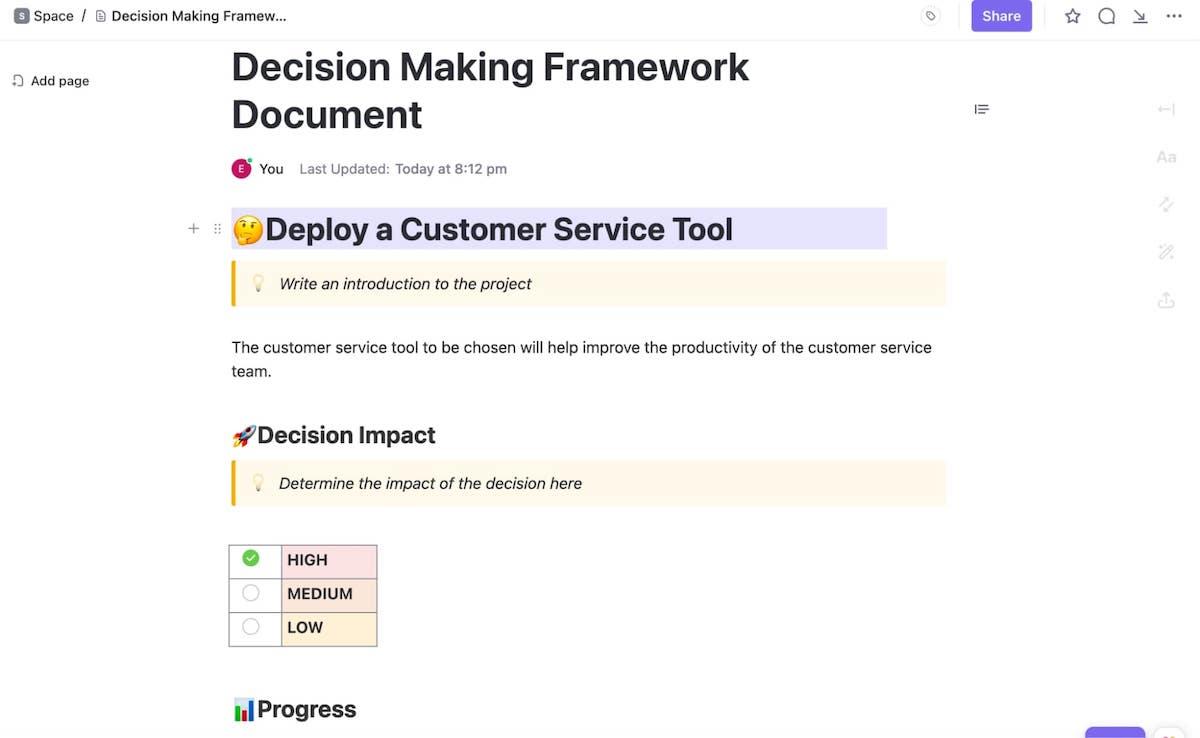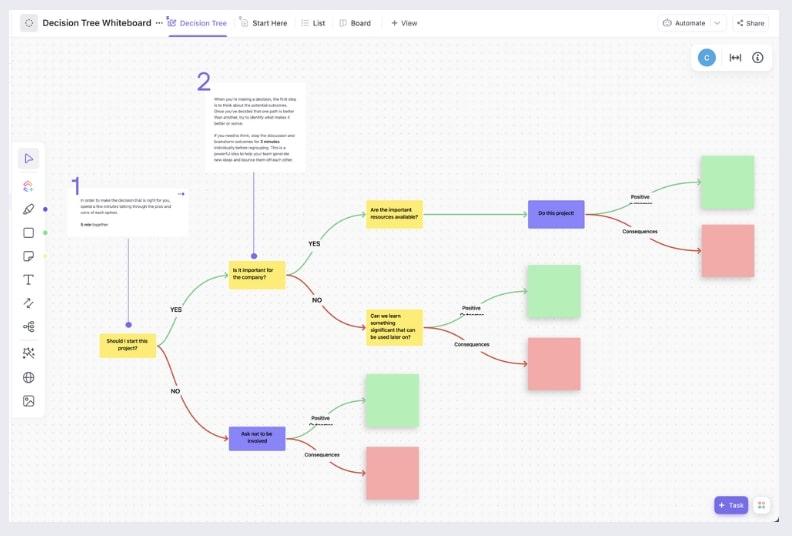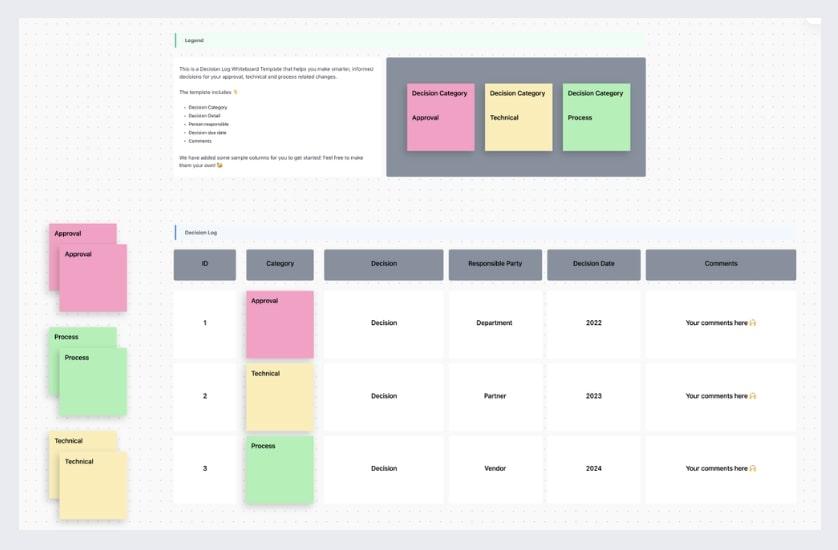7 Useful Steps in the Decision-Making Process (With Templates)

Sorry, there were no results found for “”
Sorry, there were no results found for “”
Sorry, there were no results found for “”
Decisions are a fact of life—whether you have to decide what you want for dinner, which candidate to hire for your lead IT role, or what products to bring to market this year. Every single day we make choices that can lead to progress or result in consequences.
Behind those decisions is a complex multi-step process.
Harnessing control over that process empowers your decision-making and leads to more successful outcomes. Not only do you learn how to make great decisions, but you also learn from bad decisions so you don’t make the same mistakes twice.
With this guide to the decision-making process, you’ll learn seven critical steps to making better decisions. We’ll cover the different types of decision-making methods you can leverage in your business.
Plus, we’ll highlight decision-making templates for your team to develop profitable products and meet company goals. 👀
The decision-making process is a step-by-step procedure designed to create solutions to problems based on compiling information, examining the various options, and choosing how to proceed.
From identifying the problem to reviewing all the options and implementing a plan of action, the seven-step decision-making process is well-suited for business decisions as well as more complicated personal choices. 🌻

There are several different types of effective decision-making models, including rational, creative, and intuitive—to name a few. Choosing the right model depends on the level of your decision-making skills, the amount of time you have, the nature of the decision, and your overall decision-making strategy.
Here’s a brief breakdown of the different models of decision-making to try to find possible solutions to your roadblocks. 🤔
A rational and informed decision model focuses on logically laying out all the different alternative solutions. It’s the most popular model but can also require a lot of time in terms of research.
With this model, you’ll identify all potential solutions and then work through the pros and cons of each to make an effective decision. It’s the best model for addressing problems that have a big impact on projects or the business as a whole since it involves a thoughtful and methodical approach.
The intuitive model is all about making choices based on feelings and gut instincts. It’s ideal in situations where there are time constraints since you can act quickly.
However, this approach is best reserved for experienced business decision-making personnel who’ve handled similar problems before. Since you aren’t working with data, you need to have prior experience with pattern recognition to leverage this effectively.
This model blends the approaches of rational and intuitive methods, but the defining factor is that you only assess one possible solution, rather than all of the available alternatives. Here’s how this model works:
Again, this decision-making model is best suited for experts and business leaders. It’s ideal to use for situations where time pressures exist.
This decision-making approach combines parts of the rational model and the intuitive model. It starts by gathering information on the problem and coming up with potential solutions. Instead of breaking down the pros and cons of each, you let your intuition and subconscious take over, leading you to a course of action that’s then tested.
This iterative problem-solving solution is ideal for brainstorming and experienced decision-makers like entrepreneurs.
The Vroom-Yetton model uses seven yes-or-no questions and five effective decision-making styles to guide you to the best decision. It’s one of the more complex models as you need to use a decision tree to get to the best option based on how you answer the questions and which style you choose.

This model is best for teams and collaborative decision-making. The framework has built-in steps to segment work and assign responsibility for decision-making.
Ready to discover a better way to make informed decisions? Work your way through this seven-step decision-making model when faced with a tough dilemma. From gathering information to weighing all the options, you’ll make better-informed decisions that can move the needle when it comes to your goals. ✨
The first thing you need to do is figure out what decision you’re trying to make. Maybe you have a roadblock when it comes to project execution or perhaps you have a shortage of resources.
Whatever it is, you need to clearly define the problem and scope of work before you even start thinking about solutions. To figure out what decision you need to make ask yourself the following questions:

Making informed decisions is almost always better than just making a random choice. This step of the decision-making process is critical to your success.
Start by gathering relevant information internally. Look for past situations where your team or company handled a similar problem and came up with a solution. Review project documentation to gather insights into what led to the problem at hand.
Work within your department and in related departments to collect historical data on similar issues and the decisions connected to them. Walk through their prior experience and note any insights or relevant information.

Then, go outside your organization to find available information. Market research is an excellent way to see if competitors are having similar issues. Review studies and consider working with a consultant if you want more information or expertise.
Once you have all the necessary information, it’s time to start reviewing the available options. In most cases, there will be more than one potential solution to the problem. Making the right decision will depend on your company’s needs and the market environment at any given time.
For example, let’s say you work as a marketing project manager and your goal this quarter is to increase conversions by 300%. Your possible options may be to invest in paid advertising, create new blog content, or run social media campaigns.
There are also scenarios where you may choose a couple of different decision-making models or solutions rather than just one course of action. Be careful of biases—particularly if you’ve worked on a similar problem in the past.
Just because a solution worked once before doesn’t mean it’s always the best choice in similar situations. ✍️
Now that you know your options, it’s time to start weighing the evidence to see what the best course of action is. Examine how your company or competitors have responded to similar situations in the past.
Make a list of pros and cons for each of the options. Consider if any of them offer additional rewards alongside solving the problem at hand. To do this, use strategic planning templates and methods like SWOT analysis and decision matrices.
Now is the time to make a final decision and choose a course of action. Based on the information you gathered and your review of all the options, decide how you want to proceed.
Maybe you’ll combine aspects of a few different solutions. Perhaps you’ll choose one specific approach to solve the problem. Consider all the evidence, review the alternatives, and choose the best solution.
You’ve taken the time and effort to review your options and made a choice. Next, you need to create a plan and put it into action.
Create a project plan laying out affected stakeholders and which team members will play a role. Address resource allocation and plan the budget to include your new solutions. Prioritize projects and tasks and highlight any dependencies that may affect the outcome of your course of action.
Create a clear framework of expectations for all team members, and identify decision-makers within the action phase. As Chris Small, the VP of Soundstripe, said, “Communication is easy when there is only one channel between decision and action.”

Break tasks down into easy to manage phases and be sure to let everyone know who is responsible for which decisions and actions. ✅
Back in step one, you established metrics and evaluation criteria for the problem solutions. Gauge whether you made the right decision by conducting a review of the decision-making process.
Here are some questions to ask yourself at the end of the decision-making process:
Taking action is important, but taking time to review your decisions is just as critical. Schedule a decision-making review into your project timeline to gather intel on what worked and what didn’t. Collaborate with team members to discuss their views on the process and results.
Ready to implement good decision-making processes? These decision-making templates from ClickUp make life easier whether you’re an owner in charge of business decision-making or a project manager leading a rockstar team. 💪

The Decision-Making Framework Document from ClickUp is an easy way to create a study for solving a problem and choosing the best solution.
Fill out the template steps including identifying the problem, potential solutions, and impacts to the business. The framework lets you put all your ideas in one place, allowing for better analysis.

Use ClickUp’s Decision Tree to map out possible options and solutions on a visual whiteboard. This template is ideal for teams that are looking to promote internal discussions on the best approaches.
Color-coded steps make it easy to identify roadblocks and challenges throughout the process. Best of all, the template is designed to be collaborative, so you can get input from various team members across departments.

With Clickup’s Project Management Decision Log, capture and track all decision-making processes in an easy-to-manage dashboard. Five different status options and three custom fields make it easy to see what stage of the process each decision is in.
The four view types let you sort by the calendar to see what’s happening now or view the decision board for a broader overview.

Document decision criteria, monitor progress, and assess outcomes with ClickUp’s Decision Log. Designed as a comprehensive tool, it’s ideal for managing your rational decision-making process from start to finish. Use it to create a plan for problem solving within departments, at the company level, and on specific projects.
Also Read: RACI Chart Examples and Templates
You make decisions every single day—and in business, it’s a critical component to meet goals. Spending time choosing the right approach based on your specific business needs is essential whether you’re a project manager or an entrepreneur.
Whether you’re making important decisions that affect the company’s bottom line or looking for innovative ways to serve your customers, it’s vital to put thought into the decisions you make. Acting hastily can lead to mistakes, but proper processes like the seven-step framework and methods above can help make you a better decision-maker.
Set yourself and your team up for success, and get started by using ClickUp to empower your decision-making processes. From templates that make it easier to log decisions to decision trees to map out your thought process, you’ll find countless ways to make decisions more effectively. 🙌
© 2025 ClickUp